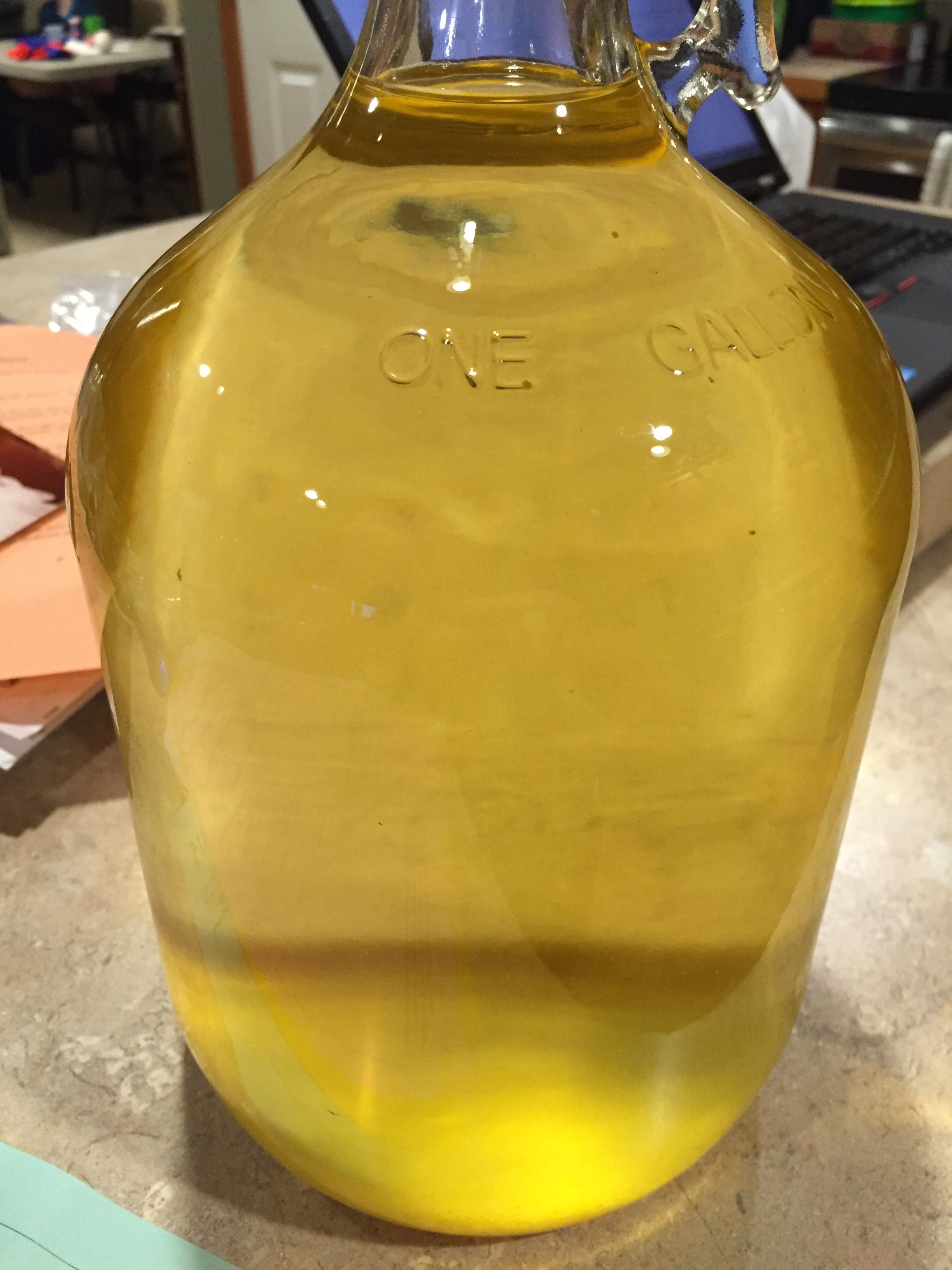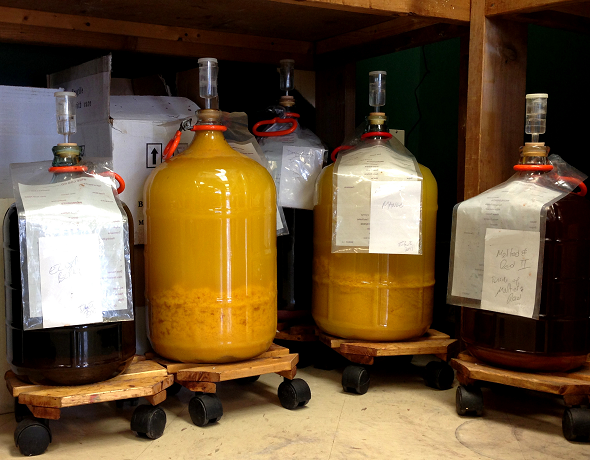madwilliamflint
Well-Known Member
- Joined
- Nov 9, 2012
- Messages
- 158
- Reaction score
- 32
Call it about 3/4. I usually get 3 bottles out of a single gallon batch, losing some to sediment, etc.

Have any one tried this wine using Bourbon mango pulp?
I have two bourbon mango trees (32 and 30 years old) in my backyard and I am getting so much mangos that I don't know what to do with then (maybe a wine).
How long can I refrigerate the mango pulp? (since I don't have all the wine gear , but intend to get it next month ).

If you can read a newspaper thru the carboy it is ready to bottle. I usually add some sparkalloid and stabilize about this time of the process to clear it out thoroughly. Then once cleared, you can back sweeten to your taste and then bottle. I usually sweeten a glass of the stabilize wine to my wife's taste, then take a gravity reading of that sample. I then gradually back sweeten the batch until it is at that gravity reading.
I think that with a gravity reading of 29 brix you are most likely correct and that it is at 18+%ABV. http://www.brewersfriend.com/brix-converter/
I use a refractometer to get the SG on my batches of mango pulp wine to get the best reading.









![Craft A Brew - Safale S-04 Dry Yeast - Fermentis - English Ale Dry Yeast - For English and American Ales and Hard Apple Ciders - Ingredients for Home Brewing - Beer Making Supplies - [1 Pack]](https://m.media-amazon.com/images/I/41fVGNh6JfL._SL500_.jpg)



Yeah that's the calculator I used. That means there was WAAAY too much sugar in there when I started. I might have to do the same thing as others and do a 2nd batch without extra sugar just to blend them together. I'll have to see if it's clear enough to read through. It is pretty clear.
Way to go HB! Now you need to author a new thread on date wines and rename yourself the Bahrain Kid! Your wife can be the Manama Mama!

My method is to just siphon it off and cry as you dump 1/3 of it down the drain

I started with 6 gallons and ended up with 4.. but that was in 2 3 gallon batches (had to make a weak one to blend with the first which was waaaay too strong). I actually just bought more mango yesterday to start a new batch of this. I want to end up with more mango flavor this time. I was thinking about adding a can of pulp after the fermentation stops, both to add the mango flavor, and to sweeten it before bottling (after stabilizing of course).
I started with 6 gallons and ended up with 4.. but that was in 2 3 gallon batches (had to make a weak one to blend with the first which was waaaay too strong).
A blend of the following recipe and the same again with no sugar:
12 30 ounce cans of mango pulp (I used Kesar - see notes)
6 kg Table Sugar (THIS WAS MY PROBLEM, 6LB was in my notes, which should have been 3 kg)
10 L water (you may need to top up later, test SG before doing so however)
9 tsp acid blend
3 tsp pectic enzyme
6 tsp yeast nutrient
2 tsp yeast energizer
1.5 tsp tannin
Fruit/skins bag
1 pkg Bentonite
1 pkg Lalvin EC-1118 yeast
Make a Bentonite slurry with 1 litre of very hot water, dissolve in the acid blend, yeast nutrient, yeast energizer and pectic enzyme. Dissolve the tannin in a separate container with a cup of water and add to this mix. Once blended, continue to add very hot water and table sugar in gradual steps, stirring well to ensure the sugar is dissolved.
Once this mix is ready, pour the mango pulp cans into a fruit bag held over the primary, tie the bag shut and place it into the primary, then stir well. Yes, quite a bit of pulp will escape the bag -- that's okay. Don't ever squeeze the bag...
Once cooled to room temperature, sprinkle the yeast over the surface and fit an airlock.
Rack from primary to secondary when SG hits 1.010 or less.
Note 1: I made two batches as I added double the sugar to the first and if it fermented dry it would have hit 20 percent ABV. The second batch used no added sugar, so would have hit 4 percent ABV at best. By mixing them they netted out at 12 percent ABV. After letting the second batch get started for a day or so I transferred half of it into a new primary, then added half of the first batch to the same new primary. I poured the other half of the first batch into the original second batch primary, then made sure both new batches were well blended. When both appeared finished I racked (most of - see note 4) half of each of them into a 6 gallon carboy, then (most of - see note 4) the remaining volume to a second 6 gallon carboy. I allowed the fermentation to complete, then racked the clear liquid to a new 5 gallon carboy and only needed a 3 gallon to take the rest of the clear product. I did top up the 3 gallon a bit. After racking a second time I ensured the 5 gallon was full and topped up the 3 gallon a little bit again. When I filtered before bottling I drew roughly half of the 3 gallon into my bottling carboy, then filtered roughly half of the 5 gallon -- of course, when I emptied the bottling carboy I filtered the remainder and completed my bottling process.
Note 2: Mango pulp cans on sale for Ramadan at FreshCo. - $1.49 down from $1.99
Note 3: This Kesar mango pulp is shipped at 15° brix, so that is factored in. The mango pulp will cause the hydrometer to float far too high or get stuck in the pulp to measure accurately.
Note 4: IMPORTANT TIP: USE THE FRUIT BAG!!! It seems like a gallon of pulp is left behind in the fruit bag when racking from the primary - don't squeeze it, but if you want you can let it drip.
Note 5: This wine needs 3-4 months to clarify. Chitosan/Kieselsol were used after second racking. You may need to use the clarifers twice.


Just as a follow up. My latest batch is now about 6 months old from primary and it is significantly better than say 3,4,5 months. This wine definitely smooths out and the mango flavor really starts to come out. I would suggest a minimum bottle aging period of 6 months.
First rack after about a month.
How does it not all fall out?
If it was me I would turn them into pulp using an immersion blender, or a regular blender which would require a bit more work. Freezing them was a good step. once thawed they should be mushy and easier to break down.Everyone is using mango pulp, I have fresh frozen mango's would like a recipe for using fresh/frozen mangos. Don't want to mess this up, all that cleaning and cutting I have about 38 lbs. of them in the freezer.